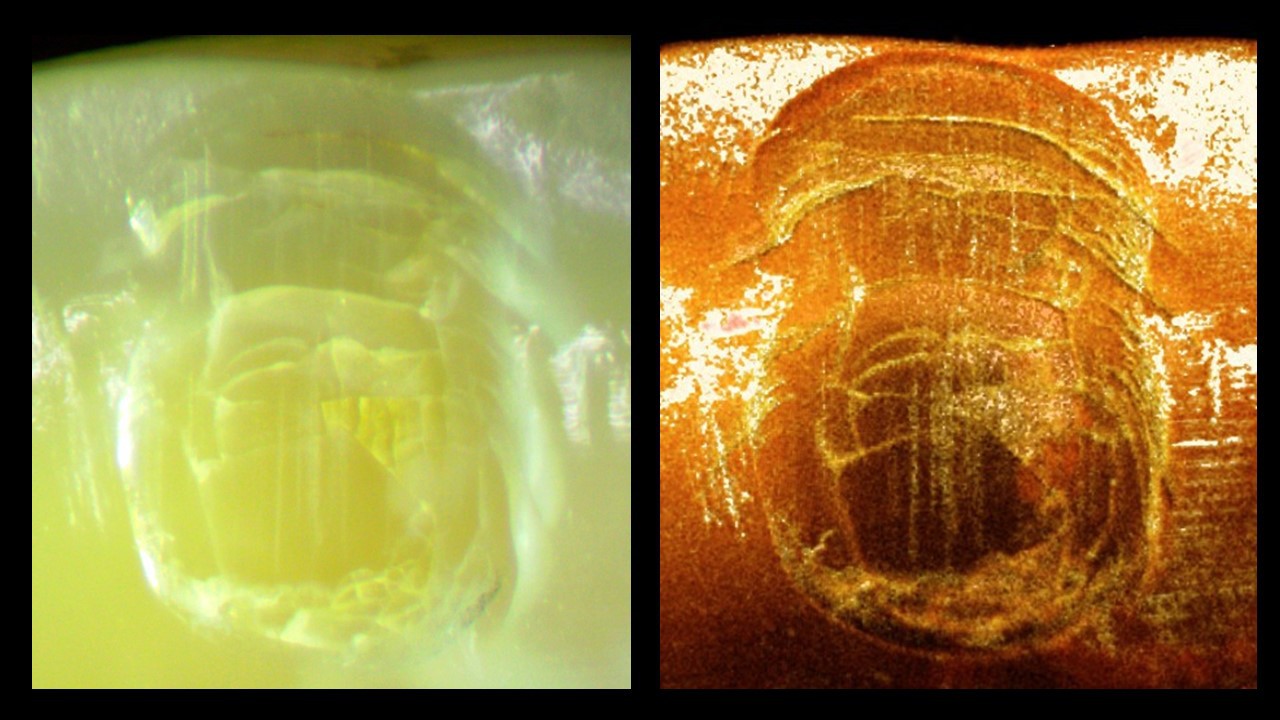IADR Abstract Archives
3D Crack Detection and Quantification in Ceramic Restorations by OCT
Objectives: The current methods for detection and quantification of cracks in ceramic restorations such as transillumination, optical microscopy or SEM lack sensitivity. Swept-source optical coherence tomography (SS-OCT) has shown the potential for in-depth imaging within lithium disilicate ceramic restorations. This study evaluated SS-OCT for 3D detection and quantification of cracks in ceramic onlays after dynamical loading and thermocylcing.
Methods: Lithium disilicate ceramic onlays in Groups of varying thicknesses: A=0.3, B=0.5, C=0.8, D=1.5 mm were adhesively cemented to molars with no occlusal enamel. The onlays were subjected to 1.2 million cycles of dynamic loading with a sliding contact on a cusp inclined plane (MSD thesis, Suarez 2016). The wear facets on these dynamically tested specimens were evaluated with transillumination optical microscopy; imaging software was used to measure the dimensions of detected cracks in the ceramic. Then SS-OCT (Santec, Japan) at 1300 nm center wavelength was used to scan specimens in 3D. Amira software was used to visualize and quantify the ceramic cracks and interfacial gaps. A novel variable was calculated from 3D images; Total Crack Percentage (TCP)= Sum of Areas of all cracks/Total Facet Area x 100.
Results: The 1.2 million cycles of sliding contact resulted in ceramic wear facets of approximate dimensions 3mm x 4mm x 0.4mm depth. Qualitative comparison suggested that many of the in-depth cracks and interfacial debonding revealed in the OCT 3D analysis were not visualized with optical microscopy. With n=5 per group the TCP was Group: A= 16.2%, B=13.4%, C=7.2%, D=5.2%. Kruskal-Wallis test followed by Mann Whitney U pairwise comparison revealed that Group D was significantly different than Groups A and B (p< .009). Frequencies of specimens exhibiting no cracks were: A=0, B=0, C=2, D=3.
Conclusions: Crack formation through the adhesively cemented occlusal ceramic was dependent on ceramic onlay thickness. Subsurface cracks through the onlay were frequently associated with interfacial debonding along the ceramic-cement interface. SS OCT was remarkably more sensitive for detection of cracks than optical microscopy. SS-OCT is a powerful tool for 3D detection, dynamic visualization and quantification of cracks and interfacial gaps in cemented ceramic restorations.
Methods: Lithium disilicate ceramic onlays in Groups of varying thicknesses: A=0.3, B=0.5, C=0.8, D=1.5 mm were adhesively cemented to molars with no occlusal enamel. The onlays were subjected to 1.2 million cycles of dynamic loading with a sliding contact on a cusp inclined plane (MSD thesis, Suarez 2016). The wear facets on these dynamically tested specimens were evaluated with transillumination optical microscopy; imaging software was used to measure the dimensions of detected cracks in the ceramic. Then SS-OCT (Santec, Japan) at 1300 nm center wavelength was used to scan specimens in 3D. Amira software was used to visualize and quantify the ceramic cracks and interfacial gaps. A novel variable was calculated from 3D images; Total Crack Percentage (TCP)= Sum of Areas of all cracks/Total Facet Area x 100.
Results: The 1.2 million cycles of sliding contact resulted in ceramic wear facets of approximate dimensions 3mm x 4mm x 0.4mm depth. Qualitative comparison suggested that many of the in-depth cracks and interfacial debonding revealed in the OCT 3D analysis were not visualized with optical microscopy. With n=5 per group the TCP was Group: A= 16.2%, B=13.4%, C=7.2%, D=5.2%. Kruskal-Wallis test followed by Mann Whitney U pairwise comparison revealed that Group D was significantly different than Groups A and B (p< .009). Frequencies of specimens exhibiting no cracks were: A=0, B=0, C=2, D=3.
Conclusions: Crack formation through the adhesively cemented occlusal ceramic was dependent on ceramic onlay thickness. Subsurface cracks through the onlay were frequently associated with interfacial debonding along the ceramic-cement interface. SS OCT was remarkably more sensitive for detection of cracks than optical microscopy. SS-OCT is a powerful tool for 3D detection, dynamic visualization and quantification of cracks and interfacial gaps in cemented ceramic restorations.

